
What mass production makes so flexible. | Was Massenproduktion so flexibel macht.
 |
Industry 4.0
→ Digital Transformation & Robot Control.
Discover Industry 4.0
Industry 4.0 combines production methods with state-of-the-art information and communication technology. The driving force behind this development is the rapidly increasing digitisation of the economy and society. It is changing the future of manufacturing and work in Germany: In the tradition of the steam engine, the production line, electronics and IT, smart factories are now determining the fourth industrial revolution.
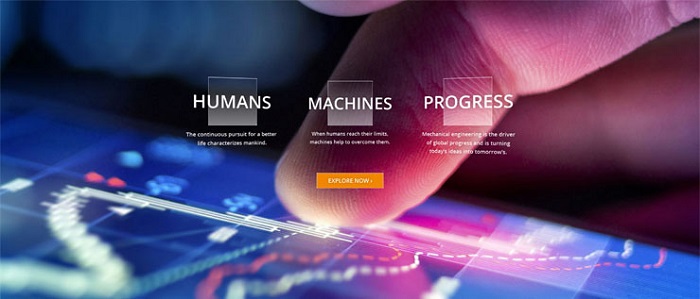
© VDMA | Humans, Machines, Progress.
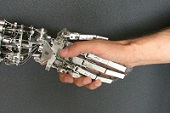
© BIOKON | What is bionics? |
Feeling pins and needles?
The "robots are bionic butterflies and robotic ants" ...
|
Bionic butterflies

Industry 4.0
Bionic butterflies combine the ultralight construction of artificial insects with coordinated flying behaviour in a collective.
Guidance and monitoring systems: cameras record the flying artificial butterflies with its infrared markers and transmit position data to a central master computer, which coordinates the butterflies from outside. The intelligent networking system creates a guidance and monitoring system in a networked factory.
[... Read more]
Robotic ants
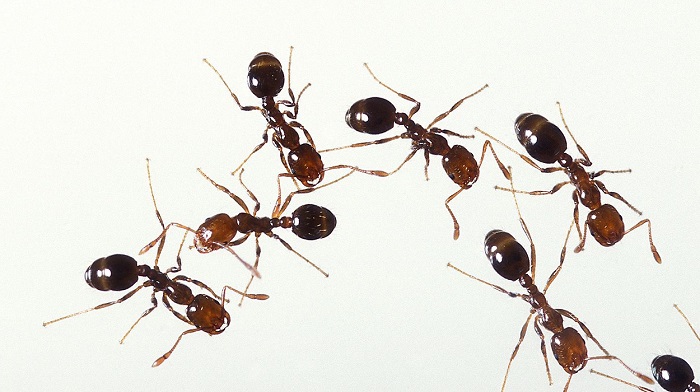
Smart Factory
The Smart Factory is core of the fourth industrial revolution towards intelligent and flexible production and for the contemporary issue "Smart Factory", the specialized industry has not only taken the delicate anatomy of the natural ant as a role model. For the first time, the cooperative behaviour of the creatures is also transferred to the world of technology using complex control algorithms,
with the uncanny result: the "Internet of Things (IoT)" connects people and things in a novel way!
The nature is the builder
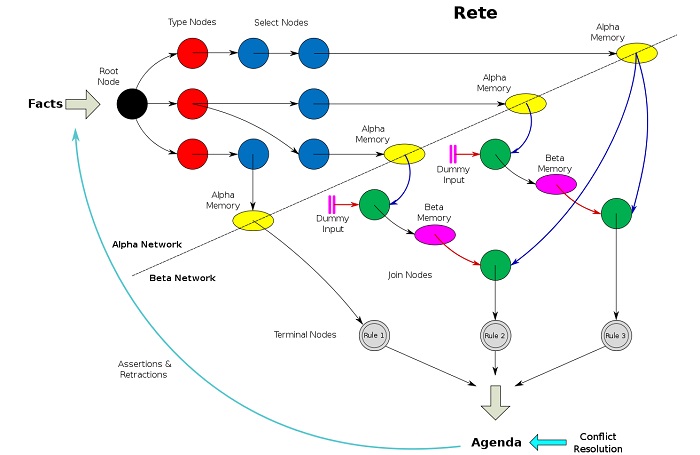
© Charles L. Forgy | "Rete-Algorithm"
Evolutionary Algorithms
Karlsruhe Institute of Technology (KIT): "Nature is the best builder!. We all have heard this sentence in biology classes at school when talking about birds? nests, anthills, or beavers? dams. Moreover, nature gives a large number of examples of various types of species that have adapted excellently to their respective living conditions. As these properties have developed without theoretical knowledge, nature is supposed to contain an effect mechanism that e.g. allows birds to fly without them knowing something about aerodynamics. Since Darwin, this mechanism has been known: It is variation in the transmission of information by heredity and selection of the best (survival of the fittest).
Evolutionary Algorithms (EA) try to reproduce the principles of natural evolution on the computer and, thus, to rear problem solutions instead of calculating them analytically."
[... Read more]
Meteoric growth
The Internet of Things (IoT) is scaling exponentially.
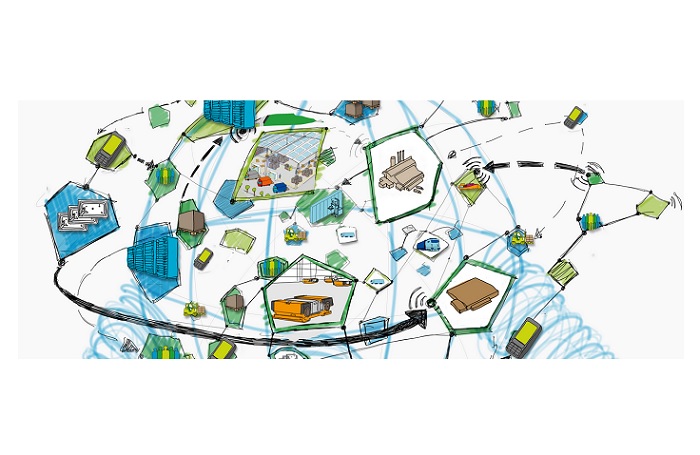
© IML | Prof Dr. Michael ten Hompel, managerial director of the institute at IML: the "Internet of Things (IoT)"
Internet of Things
Fraunhofer Institute for Material Flow and Logistics (IML): "More than a decade ago scientists at the Fraunhofer Institute for Material Flow and Logistics IML created a vision for a future-oriented logistics system where intelligent devices learnt to think and goods could organize how to get to their destination all by themselves – the Internet of Things for logistics was born. In the meantime, the Internet of Things has now become reality and is enjoying exponential growth. It is the driving force behind the digitalization of logistics and is laying the foundations for Industry 4.0."
[... Read more]
Always in touch
© KPMG Germany | Produce more rapidly, flexibly, efficiently, and with higher quality – Discover now
Connectivity
Doing Connectivity as a key category for companies means, that customer preferences even more come to the fore. Through "digitization and interconnectedness" (connectivity), all category groups of the value added chain move closer together. Customers and business partners are bounded in all processes. Digital flows of data and physical streams of values run off more and more synchro.
The holistic approach to optimize the entire value chain
What makes mass production so flexible that it can meet individual demands?
Up to now, a workpiece in a factory has been ignorant. It does not know what it is, where it comes from, and whether it is important!
This will change, and the factories of the future need to be prepared for it – above all the people working in them.
Logistics and industrial production merge
Insofar, in the stress field of strategy, process, technology and people, people more and more come under fire and so in the center of attention to prepare them for the "factory of tomorrow"!
Fast and efficient or customized and flexible
When it comes, for example to consumer goods production, "either/or" used to be an unbreakable rule. Now, hard- and software offers a new generation of machines no longer limited to strict "either/or" scenarios.
In doing so, the point is to facilitate human and machine to work hand in hand or, in technical terms, so that in factories, more and more intelligent systems have knowledge of the production process and make decisions!
What we do
With a view to a cost-efficient approach of Industry 4.0 solutions as well as the integrated analysis and use of data as the core strength for the integration of value added chain and product with the object of increasing productivity and resource efficiency
is at the heart of DBC's advisory service within the scope of the topic of "Industry 4.0".
The outcome of this are projects to launch and suitably implement Industry 4.0 software solutions.
DBC will bring up clients the topic "Industry 4.0" and clears characteristical problems:
- What do users in manufacturing companies require from software solutions, both today and in the future?
- Where do they see demand for solutions and functionalities to improve their production KPIs?
- And what obstacles are there to overcome in order to sustainably implement Industry 4.0 software solutions?
Digitalize now - the Esperanto for machinery
There are a lot of good reasons, but the main reason is: Industry 4.0 offers industry players the potential for high growth and improved efficiency and manufacturing companies are facing huge challenges:
- Reducing time-to-market
- Enhancing flexibility
- Increasing quality
- Increasing efficiency
Companies already work extensively for their digitized value chains. From there, it is to be expected, that most of the horizontal and vertical value chains in companies will be digitized as far as possible until 2020,
i. e. using digital systems, companies will have linked their machines, storage systems and operating assets through global networks already in 2020. Then, the ongoing sharing of information around the clock and around the globe, will enable these interconnected systems to manage them independently themselves and working more efficiently and quicklier to identify any errors.
In order to achieve this, companies must be able to manage all-time large volumes of data via capable IT infrastructure.
Industry 4.0 - Digital Twin of the entire value chain
DBC's holistic approach covers the lifecycle of products and production processes.
Exemplification
© Germany Trade & Invest (GTAI) | Industry 4.0 - The need to become a digital enterprise
Industrie 4.0
→ Digitale Transformation & Robotersteuerung (Roboterisierung).
Entdecke Industrie 4.0
Industrie 4.0 verzahnt die Produktion mit modernster Informations- und Kommunikationstechnik. Treibende Kraft dieser Entwicklung ist die rasant zunehmende Digitalisierung von Wirtschaft und Gesellschaft. Sie verändert nachhaltig die Art und Weise, wie zukünftig in Deutschland produziert und gearbeitet wird: Nach Dampfmaschine, Fließband, Elektronik und IT bestimmen nun intelligente Fabriken (sogenannte „Smart Factories“) die vierte industrielle Revolution.
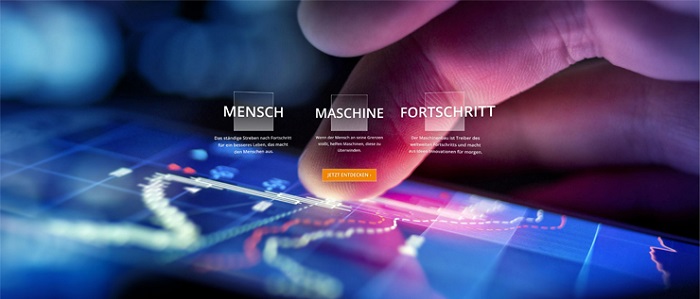
© VDMA | Mensch, Maschine, Fortschritt.

© BIOKON | Was ist Bionik? |
Es kribbelt im Bauch?
Die "Roboter sind bionische Schmetterlinge und robotische Ameisen" ...
|
Bionische Schmetterlinge

Industrie 4.0
Bionische Schmetterlinge vereinigen den Ultraleichtbau künstlicher Insekten mit dem koordinierten Flugverhalten im Kollektiv.
Leit- und Monitoringsysteme: Kameras erfassen die fliegenden künstlichen Schmetterlinge mit ihren Infrarotmarkern und leiten Positionsdaten an einen zentralen Leitrechner weiter, der die Schmetterlinge von außen koordiniert. Durch die intelligente Vernetzung entsteht ein Leit- und Monitoringsystem in einer vernetzen Fabrik.
[... Mehr erfahren]
Robotische Ameisen

Smart Factory
Die Smart Factory ist das Kernstück der vierten industriellen Revolution als Schritt in Richtung einer effizienten ressourcenschonenden Produktion und für das aktuelle Thema "Smart Factory" hat sich die spezialisiete Industrie nicht nur die filigrane Anatomie der natürlichen Ameise zum Vorbild genommen. Erstmals wird auch das kooperative Verhalten der Tiere mittels komplexer Regelalgorithmen in die Welt der Technik übertragen,
mit dem frappierenden Ergebnis: das "Internet of Things (IoT)" verbindet Menschen und Dinge auf neuartige Weise!
Die Natur ist der Baumeister

© Charles L. Forgy | "Rete-Algorithmus"
Evolutionäre Algorithmen
Karlsruhe Institute of Technology (KIT): "Die Natur ist der beste Baumeister! Diesen Satz haben wir im Biologie-Unterricht angesichts von Vogelnestern, Ameisenhaufen oder Biberdämmen alle schon einmal gehört. Mehr noch, die Natur liefert eine Fülle von Beispielen für die unterschiedlichsten Arten, die hervorragend an die jeweiligen Lebensbedingungen angepaßt sind. Da die Herausbildung dieser Eigenschaften ohne theoretisches Wissen erfolgte, muss in der Natur ein Wirkmechanismus enthalten sein, der z.B. den Vögeln das Fliegen gestattet ohne dass sie etwas über Aerodynamik wissen. Seit Darwin ist dieser Mechanismus auch bekannt: Variation bei der Informationsweitergabe durch Vererbung und Selektion der Besten (survival of the fittest).
Evolutionäre Algorithmen (EA) versuchen nun, die Prinzipien der natürlichen Evolution im Computer nachzubilden, um damit Problemlösungen quasi zu züchten anstatt sie analytisch zu berechnen."
[... Mehr erfahren]
Rasantes Wachstum
Das Internet der Dinge (IoT) skaliert exponentiell.

© IML | Prof Dr. Michael ten Hompel, geschäftsführender Institutsleiter am IML: das "Internet der Dinge (IoT)"
Internet der Dinge
Fraunhofer Institut für Materialfluss und Logistik (IML): "Bereits vor mehr als einem Jahrzehnt haben Wissenschaftler vom Fraunhofer-Institut für Materialfluss und Logistik IML die Vision eines zukunftsweisenden Logistiksystems erschaffen: Intelligente Geräte sollten denken lernen und Waren ihren Weg zum Ziel selbst organisieren – das Internet der Dinge für die Logistik war geboren. Inzwischen ist das Internet der Dinge Realität, es wächst exponentiell, es ist Treiber für die Digitalisierung der Logistik und legt die Grundlagen für Industrie 4.0."
[... Mehr erfahren]
Immer verbunden sein
© KPMG Deutschland | Schneller, flexibler, effizienter und hochwertiger produzieren – Erfahren Sie wie
Connectivity
Doing Connectivity als Schlüsselkategorie bedeutet für Unternehmen, dass Kundenwünsche noch stärker in den Mittelpunkt rücken werden. Durch "Digitalisierung und Vernetzung" (Connectivity) rücken sämtliche Bereiche der Wertschöpfungskette enger zusammen. Kunden und Geschäftspartner sind in sämtliche Prozesse eingebunden. Digitale Datenflüsse und physische Wertströme laufen zunehmend synchron ab.
Ganzheitlicher Ansatz zur Optimierung der gesamten Wertschöpfungskette
Was macht die Massenproduktion so flexibel, dass sie Einzelwünsche erfüllen kann?
Bisher ist so ein Werkstück in einer Fabrikanlage dumm. Es weiß nicht, was es ist, wo es herkommt und ob es wichtig oder unwichtig ist!
Das wird sich ändern, und darauf müssen die Fabriken der Zukunft vorbereitet sein – vor allem die Menschen, die in ihnen arbeiten.
Logistik und Produktion verschmelzen
Insofern gerät im Spannungsfeld von Strategie, Prozess, Technologie und Mensch mehr und mehr der Mensch unter Beschuss und damit ins Zentrum der Aufmerksamkeit, um sie für die "Fabrik von morgen" fit zu machen!
Schnell und effizient oder individuell und flexibel
Bisher war das, beispielsweise in der Produktion von Konsumgütern, ein klares "entweder/oder". Nun machen Hard- und Software eine neue Generation von Maschinen möglich, für die solche Gegensätze nicht mehr gelten.
Es geht dabei darum, Mensch und Maschine der Zukunft in die Lage zu versetzen, Hand in Hand zu arbeiten, d. h. in Fabriken gibt es künftig mehr und mehr intelligente Systeme, die über Wissen zum Fertigungsprozess verfügen und selbst Entscheidungen treffen!
Was wir tun
Mit Blick auf eine kosteneffiziente Umsetzung von Industrie 4.0-Lösungen sowie der Analyse und Nutzung von Daten als Dreh- und Angelpunkt für die Vernetzung von Wertschöpfungskette und Produkt mit dem Ziel der Effizienzsteigerung beschäftigt sich DBC im Rahmen von Beratungsprojekten zum Thema "Industrie 4.0"!
Daraus ergeben sich Projekte, um vernetzte Softwarelösungen für Industrie 4.0 zu starten und sinnvoll in Einsatz zu bringen.
DBC führt Klienten an das Thema "Industrie 4.0" heran und klärt typische Fragestellungen:
- Welche Anforderungen haben die Anwender in produzierenden Unternehmen an diese Softwarelösungen, heute und morgen?
- Wo sehen sie Bedarf an Lösungen und Funktionalitäten zur Verbesserung ihrer Fertigungs-KPIs?
- Welche Barrieren sind zu überwinden, um Industrie 4.0 Softwarelösungen nachhaltig zu implementieren?
Jetzt digitalisieren - das Esperanto für Maschinen
Es gibt viele gute Gründe, aber der Hauptgrund ist: Industrie 4.0 hat hohes Nutzenpotenzial für Unternehmen und die Fertigungsunternehmen stehen vor großen Herausforderungen:
- Time-to-Market verkürzen
- Flexibilität erhöhen
- Qualität steigern
- Effizienz steigern
Unternehmen arbeiten bereits aktiv an der Digitalisierung und Vernetzung ihrer Wertschöpfungskette. Es ist daher erwarten, dass die meisten der Wertschöpfungsketten in den Unternehmen bis 2020 weitestgehend digitalisiert sein werden,
das heißt, Unternehmen werden künftig ihre Maschinen, Lagersysteme und Betriebsmittel schon bis 2020 durch digitale Systeme weltweit vernetzt haben. Durch den permanenten Informationsaustausch rund um die Uhr und rund um die Welt werden vernetzte Maschinen dann in der Lage sein, sich selbstständig zu steuern, effizienter zu arbeiten und Fehler schneller zu erkennen.
Voraussetzung dafür ist die Möglichkeit, bisher unerreichte Datenmengen durch geeignete IT-Infrastrukturen zu managen.
Industrie 4.0 - Digitaler Zwilling der gesamten Wertschöpfungskette
DBC's ganzheitlicher Lösungsansatz umfasst den Lebenszyklus des Produkts sowie der Produktion.
Erläuterndes Beispiel
© Bayerischer Rundfunk (BR) | Industrie 4.0 - Die Notwendigkeit, ein digitales Unternehmen zu werden
|
